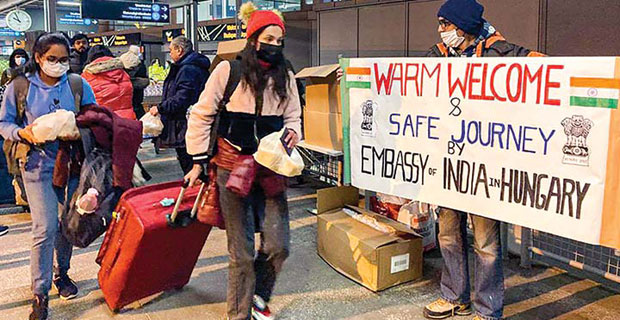OPERATION GANGA: HOW INDIA GOT ITS CITIZENS OUT OF UKRAINE
To have evacuated safely more than an estimated 18,000 Indian nationals from Ukraine amidst the ongoing conflict, is truly a commendable task
Coordination for the operation came right from the top and dispatch of senior ministers of the government to the countries mentioned above provided the necessary coordination and direction on the ground to ensure smooth completion of all formalities. That the Prime Minister himself held daily meetings to supervise this mission demonstrated India’s seriousness. Modi sent four Ministers, namely Jyotiraditya Scindia, Hardeep Singh Puri, Kiren Rijiju, and V.K. Singh to Hungary, Romania, Slovakia, and Poland, respectively, to oversee the evacuation of Indians.
The real challenge of evacuating those Indians stuck in eastern Ukraine was moving people amidst the raging conflict. This is why India proposed the creation of humanitarian passages to both Russia and Ukraine, so that the evacuation would be less hazardous. India deployed one team also in the Russian city of Belgorod, close to the border with Ukraine, in case the possibility of evacuation from the Russian side arose. This did not happen given the intensity of conflict in eastern Ukraine. The closure of the Ukrainian air space further complicated matters as India could not extricate its nationals from Kiev or any other Ukrainian city. This is what created the necessity of moving most people by road or rail to friendly countries across the Ukrainian border for eventual evacuation by air to India.
India now has considerable experience of Humanitarian Assistance and Disaster Relief, both within the country and overseas. It has also functioned as a first responder to countries in its neighbourhood, like it did in Nepal during the 2015 earthquake. The lessons from Operation Ganga will definitely be internalised and adopted to meet such contingencies in the future. The reality is that Indians are spread and settled all over the world and many of them are resident in potential conflict zones. The case of Ukraine is a telling example of how a perfectly quiet situation can turn into a ‘hot’ zone in a short time. The way forward is for India to further refine its capabilities of evacuation, while monitoring the presence of Indians in potentially hazardous zones.
Overall, though it must be said “job well done”, when looking back at Ukraine.











Comments.